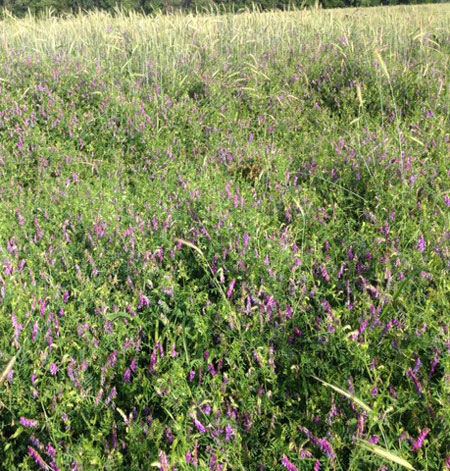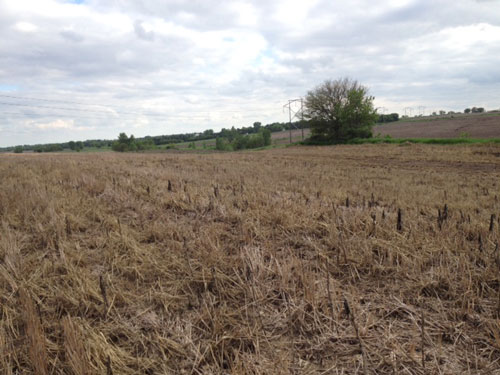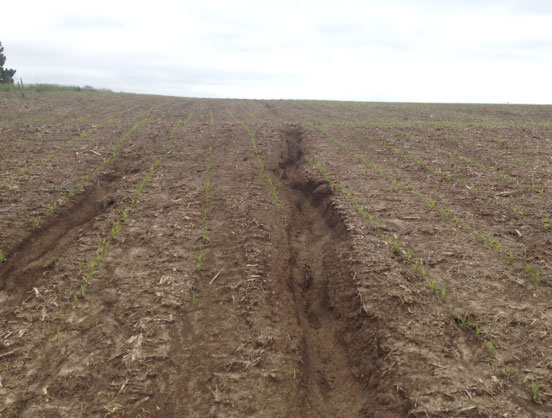Cover Crops for Prevented Planting Acres
June 30, 2015
Wet conditions have persisted across eastern Nebraska, and as spring planting winds down, some growers have been unable to complete their usual plantings. These growers have a number of alternatives for the unplanted acres, including planting this ground to cover crops. This article discusses several issues related to this alternative.
Benefits of Cover Crops

Cover crops offer several kinds of benefits. If legumes are planted, they can add nitrogen for next year's crop. Approximately half of the nitrogen (N) in the shoots of the legume will be available for the following crop one or two months after termination of the cover crop (Midwest Cover Crop Council 2014). Legumes such as hairy vetch can be a good alternative, with some providing over 100 lb of nitrogen for the next crop (Clark 2007a).
Some cover crops serve as nitrogen scavengers, meaning they take up residual soil nitrate and reduce the amount that leaches out of soil. Cereal rye or brassicas such as radishes are excellent examples of nitrogen scavengers. This process maintains water quality and protects the environment. Some cover crops such as buckwheat and radish also help recycle nutrients such as phosphorus by bringing them up from the subsoil.
Another benefit from cover crops is that they help build organic matter by adding carbon to the soil through their roots and shoots. This provides food for the microorganisms and earthworms in the soil, which helps build soil aggregates, stabilize the soil, and improve soil structure. Water infiltration rates also can be improved by using cover crops. Some of the brassica species, such as tillage radish, Ethiopian cabbage, and rape, are used to help penetrate the soil in this fashion.
Reducing erosion is a primary goal of using cover crops for some producers. Cover crops add plant diversity to the soil, which helps reduce insect and disease pest issues. Cover crops such as cereal rye have been shown to be very good at suppressing certain weeds such as marestail (Clark 2007b). In soybeans, cover crops such as cereal rye and rape have been shown to suppress foliar diseases and reduce impact of soil borne pathogens like Sudden Death Syndrome (SDS) and Soybean Cyst Nematode (SCN), according to research conducted in Illinois (Eastburn 2012). Cover crops also can be an excellent source of forage for livestock and still provide cover for erosion protection.
Suitable Cover Crops for Eastern Nebraska
A number of cover crops are well suited to eastern Nebraska, depending on your goals and how much you want to spend on cover crop seed to achieve your goals. In prevented planted acres, the use of cover crops is an opportunity to build soil. If grazing cover crops after November 1 is a goal, you will want to plant different cover crops that would benefit fall and even spring grazing. (Prevented planted acres cannot be grazed prior to November 1 to receive full payment.)
Other goals for planting cover crops include: adding carbon to soil to build organic matter, planting legumes to provide nitrogen for the next crop, using cover crops to scavenge nutrients, and planting cover crops to reduce weeds and diseases.


Planting warm-season grasses is an excellent way to add carbon to your soil. Warm-season grass cover crops include sorghum-Sudan grass, pearl millet, grain sorghum, and corn. These are all excellent nitrogen scavengers that will produce significant biomass and die out with the first hard freeze. Other grass cover crops include cereal rye, annual rye grass, wheat, triticale, barley and oats. Cereal rye is probably the most versatile of these cover crops. It provides excellent benefits, while being the most winter hardy. If there is concern about terminating the cover crop next spring, oats is a safe grass to use, as it will die out in the fall. It is popular in grazing mixes with brassicas such as turnips, rape, collards, and radishes.
If one goal is to provide some nitrogen for next year's crop, several types of legumes can be planted as cover crops. They include hairy vetch, several types of clover (red, ladino (white), or crimson), and other legumes, such as field or winter peas, cowpeas, soybeans, or sunn hemp. Mixes with clovers and vetch provide excellent grazing as well.
On fields that are low in fertility, especially nitrogen, applying 50 lb of nitrogen will help give the cover crops a jump start, particularly the summer annuals like sorghum-sudan, millets, and brassicas.
In planting cover crops be aware of herbicides that were used on the previous crop that would prohibit planting a cover crop and/or grazing or harvesting your cover crop. (See Review Herbicide Restrictions Before Planting Forage Cover Crops.)
Cover crops can be planted as single species or in mixed species. Single species are easier to manage, while mixes provide diversity and multiple benefits.
Simple Cost-Benefit Estimates
Cover Crop Seed Suppliers
In Nebraska we are fortunate to have a number of excellent cover crop seed suppliers. Farmers can work with their local ag or seed supplier or contact one specializing in cover crops. Cover crop seed suppliers in Nebraska include:- Arrow Seed Company – Rich Russell, 126 N 10th Ave, Broken Bow, NE 68822
(308) 872-6826, arrowseed.com/cover-crops/ - Green Cover Seed – Keith and Brian Berns, 918 Road X, Bladen, NE 68928
(402) 469-6784, greencoverseed.com/ - Prairie States Seed – Brad Young, 88112 545 Ave, Bloomfield, NE 68718
(402) 373-2514, www.prairiestatesseed.com - Roberts Seed, Inc. – Joe and Leisha Roberts, 982 22 Road, Axtell, NE 68924
(308) 743-2565, www.robertsseed.com - Stock Seed Farm – Mike Fritz, 28008 Mill Rd, Murdock, NE 68407
(402) 867-3771, www.stockseed.com/ - The Seed House – Don O'Bryan, , 87194 494th Ave., O'Neill, NE 68763
(402) 394-8517, seedhouse@telebeep.com
Note: Reference to commercial products or trade names is made with the understanding that no discrimination is intended and no endorsement by Nebraska Extension is implied.
The cost of putting in cover crops can vary, depending on the seed and whether additional fertilizer and herbicide is necessary. The University of Nebraska-Lincoln recently conducted five on-farm research studies of cover crop use. Costs ranged from about $24 per acre for a minimal approach (rye seed and drilling) to about $58 per acre for a "cocktail" seed mix terminated with a herbicide application.
Seed costs in these five studies ranged from about $11 per acre for rye seed to $27 per acre for cocktail mixes which included a wide range of crops. The three cocktails used in these studies included various combinations of winter pea, mung bean, pearl millet, oats, radish, sunflower, sorghum and Sudan crosses, turnips, clover, vetch, flax, and rapeseed. The cocktails typically cost over $20 per acre for seed.
Drilling costs in these studies ranged from $7 to $13 per acre. A full accounting of cost would include not only fuel and labor costs, but also a charge for the use of the drill and tractor. Not all of these are cash expenses.
Herbicide applications may be needed to terminate a cover crop. In the single study where it was necessary, the cost came to about $19 per acre. Winter kill was the simple and free means of termination in most of these studies.
These costs are offset by a variety of benefits. One benefit is the nitrogen value of the cover crop, which could range from $5.70 per acre for rye (10 lb @ $0.57/lb N) to $45.60 for vetch (80 lb @ $0.57/lb N). The value of other benefits such as reduced erosion, higher organic matter, etc., is more difficult to estimate but is also quite real.
We often observe another benefit in the form of increased production of the following row crop. Research studies usually show at least a 10% increase in yield when switching to well-managed, no-till sod planting on erosive soils. With a yield of 140 bushels per acre for corn, that could add $49 per acre to gross returns (14 bu @ $3.50).
Prevented Planting Payments and Cover Crops
Insured growers who were prevented from planting their normal insured crop may be eligible to receive a Prevented Planting (PP) payment under their crop insurance policy.
In general, a prevented planting payment is available for land that could not be planted due to an insured cause of loss during the normal planting period (that is, prior to the final planting date) and the late planting period. To qualify for a prevented planting payment, the unplanted acreage must be at least 20 acres or 20% of the crop acreage in the insured unit, whichever is less.
Crop insurance rules carry some restrictions, however, if the grower wants to plant a cover crop and still retain their prevented planting payment. Namely, a grower can plant a cover crop during or after the end of the late planting period and receive a full PP payment so long as the cover crop is not hayed or grazed before November 1. Also, the cover crop cannot be harvested for grain or seed at any time.
The normal prevented planting payment from crop insurance is calculated as 60% of the production guarantee for eligible timely planted acres. For example, consider a soybean grower who has an APH yield of 45 bushels per acre and selected 80% Revenue Protection coverage. With the $9.73 projected price, the grower has a revenue guarantee of $350.28 per acre (45 bu/ac x $9.73/bu x 80%). The prevented planting payment is 60% of this amount or $210.17 per acre.
The final planting date for crop insurance is the last day to plant an insured crop and still receive the full level of insurance coverage. For Nebraska in 2015, this date was May 25 for corn and June 10 for soybeans. The late planting period is an additional period after the final planting date in which the insured crop can be planted and receive a lower level of insurance coverage. The late planting period in Nebraska was 20 days for corn and 25 days for soybeans. This means the late planting period for corn ended June 14, and for soybeans it ends July 5.
As always, check your plans with your crop insurance agents to ensure compliance with the coverage and to determine expected payments, reporting requirements, and other details.
Cover Crop Resources
For more information about cover crops, see these resources:
- USDA Cover Crop Chart — valuable information about different cover crop types
- Green Cover Seed's SmartMix Calculator
- The Midwest Cover Crops Council Field Guide was a source of most of this information on cover crops.
- SARE (USDA Sustainable Agriculture Research and Education) offers cover crop information at www.sare.org/Learning-Center/Topic-Rooms/Cover-Crops
- The SARE Cover Crop Book, Managing Cover Crops Profitably, 3rd Edition, can be downloaded at www.sare.org/Learning-Center/Books/Managing-Cover-Crops-Profitably-3rd-Edition
References
Clark, Andy. 2007a. Managing Cover Crops Profitably, 3rd Edition. p. 67, 142-151.
Clark, Andy. 2007b. Managing Cover Crops Profitably, 3rd Edition. p. 98-105.
Eastburn, Darin. 2012. Suppression of Soybean Diseases Through the Use of Cover Crops, 2012 SARE Annual Report.
Midwest Cover Crop Council, 2014. Midwest Cover Crops Field Guide, 2nd Edition. p. 8
Monte Vandeveer
Gary Lesoing
Nebraska Extension Educators
Online Master of Science in Agronomy
With a focus on industry applications and research, the online program is designed with maximum flexibility for today's working professionals.
